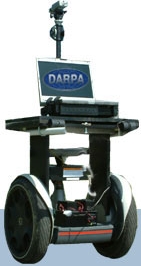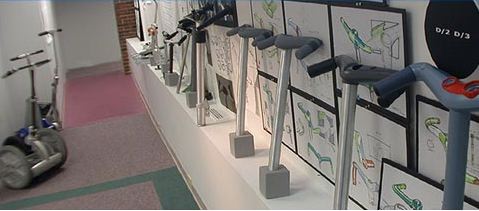


Gallery Commentary
Back when I was a postdoc in California, on a sunny afternoon walking across the Quad at Stanford University it was not unusual to see some primitive R2D2-like robot struggling to get around with
smiling students and their laptops closely in tow.
Thus it's not surprising to me that in the 2003-2004 time period, scientists who work in robotics began buying HTs and converting them to other sorts of robots (the Segway HT is itself already a robot, of course). Engineers at LLC would work closely with these customers to help them succeed. Eventually the company decided to market pre-made mobility platforms (the robot version of "feet") so engineers, scientists, professors and students around the world could add their robot to the top of a Segway HT. Currently there are four different versions of the RMP that are derived from the p Series, the i Series and even a monster RMP with wheels from the XT. Interestingly, only two of the four models have the capacity to balance with the dynamic stabilization technology Segway LLC is known for. The simplest (RMP 50) model and the monster (RMP 400) model have three and four wheels respectively and hence don't need the two wheel balancing feature.
The Segway LLC website's RMP product description:
The Segway Robotic Mobility Platform (RMP) takes the performance and engineering prowess demonstrated in the Segway Human Transporter (HT) and makes it available in a
durable package for robotics applications. The Segway RMP is an extremely reliable and customizable transportation platform that is suitable for moving heavy payloads in
tight spaces over a variety of terrain.
The Segway RMP product line uses the same components that enabled a Segway HT rider to travel more than 4,000 miles across the United States. These components were
designed and tested to be highly reliable and durable -all while maintaining a reasonable cost.
Each Segway RMP model is electric and emits only a slight harmonic hum when the drive motors are active. It also has an onboard charging system and is controlled via a
simple USB or CAN serial bus interface. Custom interfaces are also available. The Segway RMP base is well sized to augment or replace human power in a variety of applications.
Its motors are capable of producing 2 HP continuously and can peak at 4-5 HP as needed-powerful enough to carry a human-sized payload. Segway RMP models are available in a variety
or battery and tire/wheel combinations and offer a range of up to 15 miles / 24 km and payload capability of up to 400 lbs / 181 kg. The Segway RMP runs on one to four NiMH or li-ion
battery packs. Each Segway RMP can be powered by any electrical energy source provided it produces 52 volts. In fact, the Segway RMP may be outŪtted with a compact gas generator to
charge the batteries while in use. Segway RMPs have a propulsion base that is found in other Segway products currently in the marketplace. Some models include support frames for custom sensing devices and computing
hardware, casters for statically stable operation, or connection points for attaching one Segway RMP to another. Modular capability within the Segway RMP product line enables a small
number of units to be reconfigured as needs change. The Segway Robotic Mobility Platform is available for delivery to commercial customers now.
|
|
||||||||||||||||||||||||||||||||||||||||||||||||||||||||||||||

